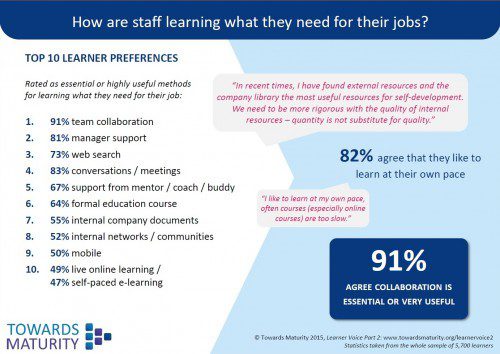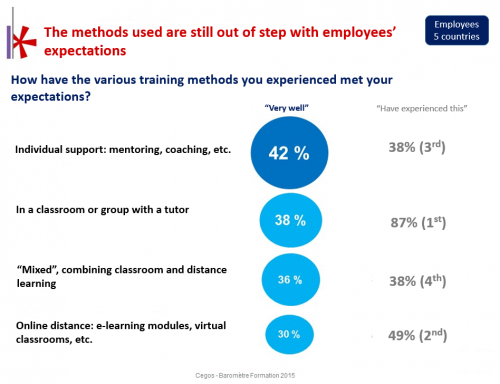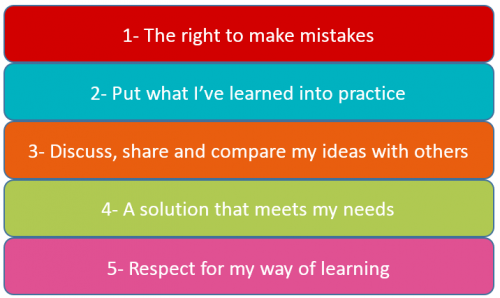To what extent do we really take account of a learner’s needs when we develop our learning programmes?
This blog includes the findings from two recent surveys – Towards Maturity’s ‘The Learner Voice’ (5,700 employees surveyed in the United Kingdom and Europe) and Cegos’ European research (2,500 employees surveyed in five European countries).
Learning is a social act
Philippe Carré is correct when he writes: “We always learn on our own but never without others.”
In the two surveys cited in the introduction, respondents highlighted their preference for collaborative learning or learning with the support of a tutor.
In the survey ‘The Learner Voice’, for example, team collaboration was found to be the most popular learning method at work – 91% of all respondents and 96% of new entrants said this.
In the Cegos ‘Barometer’ survey, individual support was by far the most popular of the four options proposed.
The image above shows the discrepancy between employees’ preferred learning methods (in the blue circle) and the methods they are actually offered (on the right).
This gap was clearly demonstrated in the Cegos survey with regard to personalised training. In all countries apart from Great Britain, employees (blue histogram) want training to be personalised, wheras HR departments (yellow histogram) tend to focus on collective activities.
Although the overall ranking of preferences remains unchanged, it is worth noting several differences between certain groups:
- Employees with a higher level of initial education tend be happier with online distance learning than others.
- People under the age of 35 slightly prefer online distance learning, where 33% said it “completely meets my needs” compared to only 26% of those over 45 who say the same. However, we note that there is no enthusiasm among the youngest employees for distance learning.In the survey ‘The Learner Voice’, intergenerational differences are not particularly marked. However, employees in the 21-30 age group are more inclined to cooperate and share knowledge via social media – 84% responded “I like to share what I know with my colleagues”, compared with 70% of the over 50s.
- Employees in businesses with fewer than 500 employees are more likely to rank distance learning and support in first place than those in large businesses.
A survey conducted previously highlighted some fundamentals about what factors are important to learners:
Conducting your own end-user survey
In these times of rapid change, major operational constraints and ‘infobesity’, it is more essential than ever to talk to the recipients of training.
You need to ask them about what they need to learn, how they like to learn, and what prevents them from learning.
Among the factors that prevent online learning, the ‘The Learner Voice’ survey lists:
- Lack of time for self-guided learning (63%)
- Not being able to find what I need (40%)
- Not having an appropriate space for learning (28%)
- Lack of interesting training content (26%)
- Technological problems, such as bandwidth (25%)
“Are Learning & Development professionals tuned into the learner voice?” asks the survey.
This is a good question and I recommend your run a survey among end-users of your own training programmes to help you listen more effectively.





Leave a comment